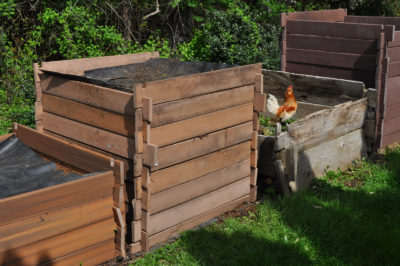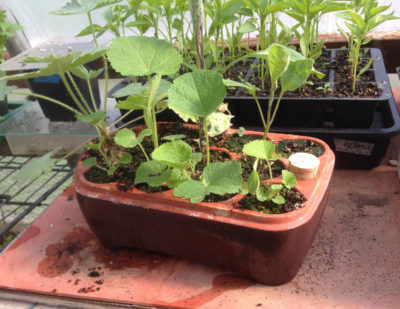DESIGNS ON GARDENING
The Turn Of The Year
Sure there’s seed-sowing, weeding, and pruning to do, but I’ve also been spending a good amount of time communing with my pitchfork. Turning compost.
Some people are put off by the thought of having to turn compost. Don’t be. Compost does not have to be turned. Any pile of organic materials will eventually become compost.
Still, I like to turn my composts. I typically build new piles (a lot of them!!) through summer into fall, turn them the following spring, and then spread the finished compost that fall or the following spring. As I fork the ingredients from the old pile into the adjacent bin, I break up any clumps with the pitchfork and fluff up any parts that seem sodden and gasping for air. A nearby hose makes it convenient to spray any dry areas.
Everything organic (was once or is living) — hay, weeds, old plants, some horse manure, old cotton clothes, vegetable trimmings — goes into my compost, and that includes, unavoidably, weed seeds. Turning my compost pile exposes weed seeds buried within the pile to light, which prompts them to germinate — only to be snuffed out as they are again buried in the turned pile.
I take note of the progress of the decomposition, generally tossing any less decomposed pitchforkfuls towards the more active center of the turned pile. I also “take note” very literally, writing down a rough estimate of how far along the compost has progressed. If it’s, say, 80% finished, it should be ready for use, if needed, within a month or so. If 60% finished, it’ll have to keep cooking until fall.
I like to watch the results of the bacteria, fungi, and other compost pets nurtured within the piles. And turning them is good exercise.
Design Ultimatum
Over the years, my compost bins have gone through many incarnations as I, each time, came up with what I thought was the ultimate design for the bin itself. The present design has retained that status for a number of years now.
The present bin is made of notched boards, 24 per pile, each about 1” thick by 6” wide by 4 feet long. The boards stack up to make a cube Lincoln-log style. For a thorough enclosure, two boards ripped to half their width make up two sides of the bottom of the bin. The advantage of the notched boards is that all four sides are enclosed and the compost bin can be built higher and higher, as needed, as material is added. And lowered, in steps, as finished compost is being removed for spreading, or half-finished compost is being removed for turning into a expanding, adjacent bin.
My original “ultimate design” bins were made from wood, which needed replacement every 8 to 10 years. Present bins are made from artificial wood decking, which should hold up forever.
While not a necessity for making compost, a bin does keep everything neat and tidy, keeps scavenging animals and wind-blown weed seeds at bay, and retains heat and moisture for quicker and more thorough composting. As I wrote a few paragraphs earlier, “Any pile of organic materials will eventually become compost.”
Transplant Design
Speaking about good design . . . With so many transplants to water, any method of automatic watering is a godsend. Right now, a couple of hundred of my seedlings are growing in individual, plastic cells sitting on capillary mats. As soil dries out in the cells, it sucks up water from the capillary mat which, in turn, draws water from the reservoir below it. This, the APS system, works very well.
And now an even better design has come down the pike, one made out of terra cotta that, unless dropped, is sure to outlast plastic systems. Cells for a tray of Orta Seed Pots are all housed together in an attached reservoir. One advantage of this design is that cells absorb water throughout their terra cotta walls. Another advantage is that each cell has a drainage hole, so periodic top watering can leach out excess minerals that can build up in pots watered from below.
The only downside to Orta Seed Pots is that they are expensive. Then again, they can potentially last forever, and they grow very good plants. The design is so elegant and effective (as borne out by some seedlings that I raised in Orta’s) that I’m going to shamelessly help in their promotion with a link, (www.ortakitchengarden.com/factory-seconds-sale/),to discounted factory seconds, which work perfectly but have cosmetic flaws, or, till the end of May, discounted firsts (www.ortakitchengarden.com), with discount code ORTAMAY).


What do you use to cover your compost bin, if at all?
If you cover it, wouldn’t that suppress the air it needs to speed along composting?
I cover it with EPDM rubber roofing. There’s plenty of air in the pile when I build it. I mix fluffy stuff with denser stuff to achieve that.
Hey Lee,
How do you cut the notches?
With great difficulty. I’ve ganged the boards together with a large clamp and have made repeated cuts with a circular saw. Another time I used a router, which took 4 passes to get to full depth and width.
I use my cold frame to start seedlings and use a system similar to grocery store produce misters on timers. Works great and super low maintenance.
I heard you say once that you water your veggies for 5 Minutes 6 times a day. What times of day do you start/end watering and how long between watering times?
Thank you
8am, 10am, 12pm, 1pm, 3pm, and 5pm. I just try and spread it out over daylight hours.
We have used pallets for our three compost bins and they are falling apart after 12 years. I love the idea of using decking so it’s the last time we’ll ever have to make these. Do you feel confident that the plastic won’t leach into the compost over time? We love your blog.
Thanks.
Cheryl
The probability of plastic leaching into the compost is very low. If it was to leach, that would shorten the life of the decking; life of the decking is very long. Also, leaching is mostly downward, with the force of gravity, so even if it did leach it would hardly move horizontally into the compost. And finally, the plastic is ver insoluble, to say the least. The main downside to the plastic is cutting it. I had to spread tarps to contain the dust and shavings and, of course, wear a mask when cutting and notching the boards.
Hello, I’m trying to do the math. On average, what would one entire compost bin cost to make (out of the composite decking material)? A general estimate is fine. Thanks!
Very roughly, if I remember correctly, each of mine came to about $150.